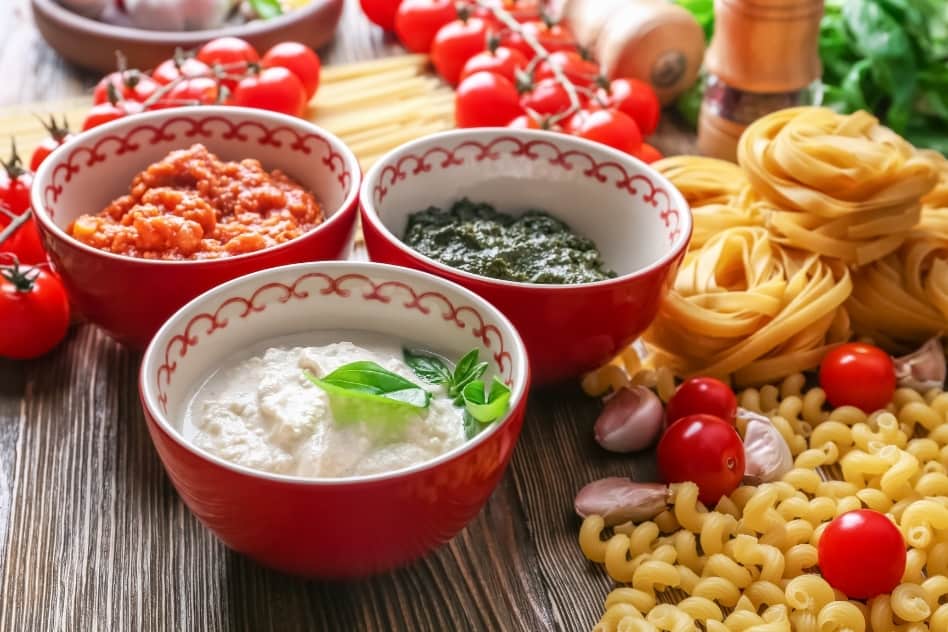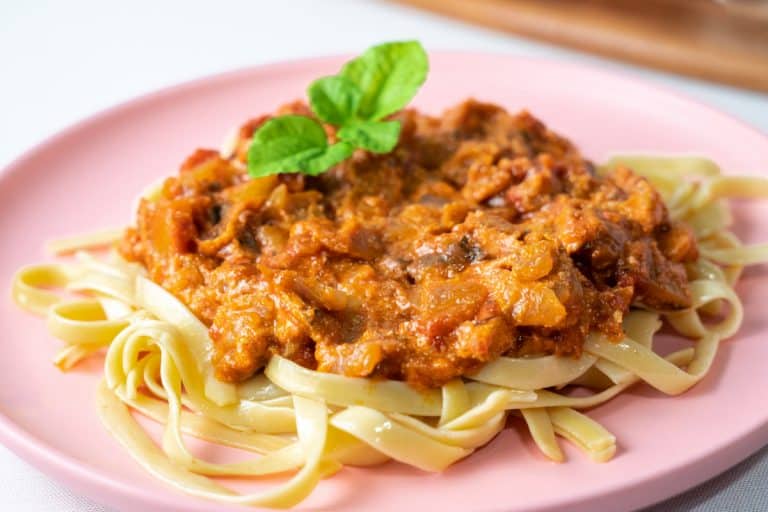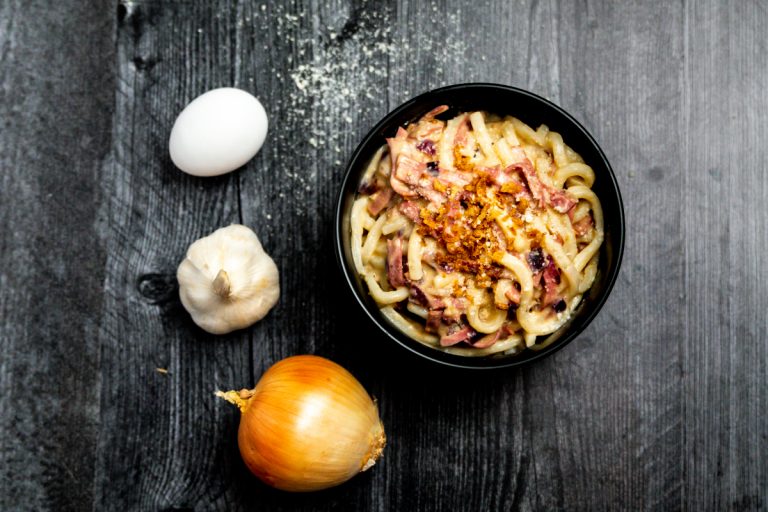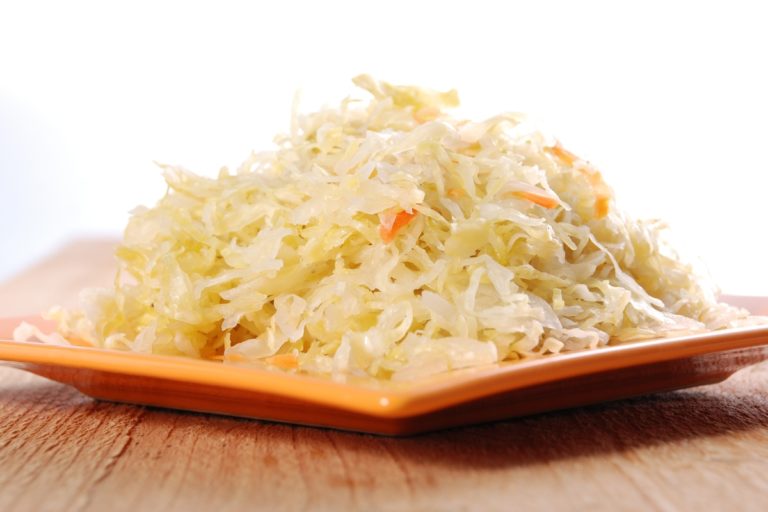Best Italian Pasta Sauces
Think pasta and you’ll naturally think of the most delicious Italian sauces, from the simple marinara to the rich pesto or the creamy bechamel.
A cauldron of tomatoes, a saucepan of cream, a mortar full of pine nuts, a handful of olives, capers, and garlic, white wine to taste, and more; all of these are thrown together to make hearty Italian sauces of different flavors.
Do you know the differences between the sauces? And what makes one sauce different from the other? Or one more suited to a dish than the other?
Here’s a lesson in the preparation of different Italian sauces and the dishes they taste the best in!
1. Classic Italian Tomato Sauce
The simplest and the most basic of all Italian sauces, the classic tomato sauce is often used for pasta and pizzas. It is also the base on which most other sauces are developed.
The main ingredients in this sauce are tomatoes, garlic, onions, basil leaves, olive oil, and sugar. Some variants may include thyme, oregano, bay leaves, or cream.
So what’s the difference between a Napoli and a Pomodoro? Or between a Pomodoro and a Marinara?
This bit can get really confusing since they’re made of the same ingredients. But the differences lie in the way they’re made.
A pomodoro sauce is thicker than a marinara, but the tomatoes used in it are minced fine, while in a marinara they’re just cut up.
Marinara is a quick-cooking sauce, so it’s lighter red in color than the pomodoro which can simmer for hours. (Westernized versions of the pomodoro sauce are often easy-cooking and can be ready in 30 minutes or so.)
Both marinara and pomodoro are used while making pasta, but if you’re making pizzas, it’s mostly the pomodoro sauce that’s used.
But don’t forget the Napoli sauce. What is a Napoli sauce?
Also called Neapolitan sauce or Napolitana sauce, Napoli sauce is a salsa di pomodoro alla napoletana. But if you find yourself in Naples and ask for your spaghetti made this sauce, you won’t find it.
In Naples, the sauce is merely called la salsa, which can confuse you even further since almost all sauces go by ‘la salsa’ or ‘the sauce’ locally in different regions of Italy.
So how do you know if you’re eating a Neapolitan sauce in Italy? Simple. If you’re in the region of Naples, and the sauce has tomatoes, basil, peppercorns, and garlic in it, it’s the Neapolitan sauce.
Depending on the region, it may also include some cloves, olives, bay leaf, thyme, oregano, or mushrooms in it.
Here are some tasty recipes using the Marinara, Pomodoro, and Neapolitan sauces.
This is a really quick recipe for a Spaghetti Al Pomodoro that you can make in just 15 minutes!
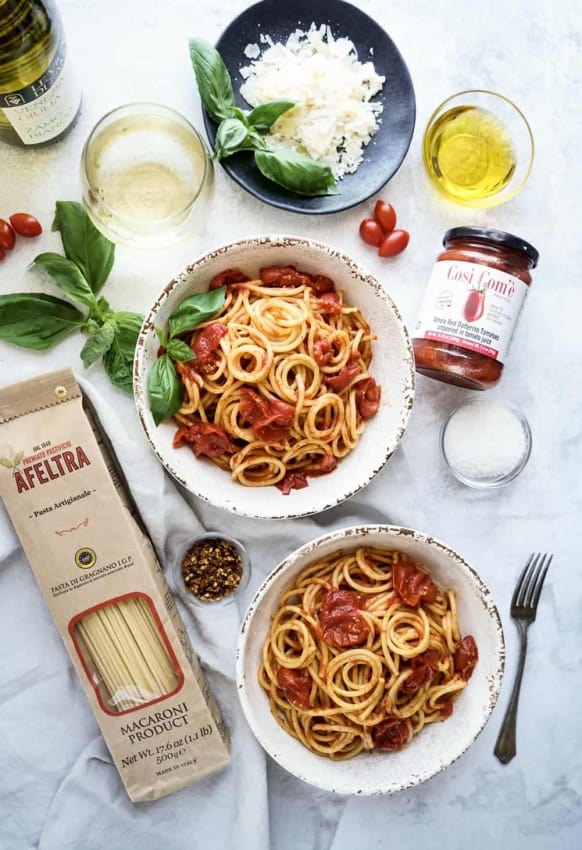
As Italian as it gets, Neapolitan sauce recipe is easy to make sauce with only a few ingredients.
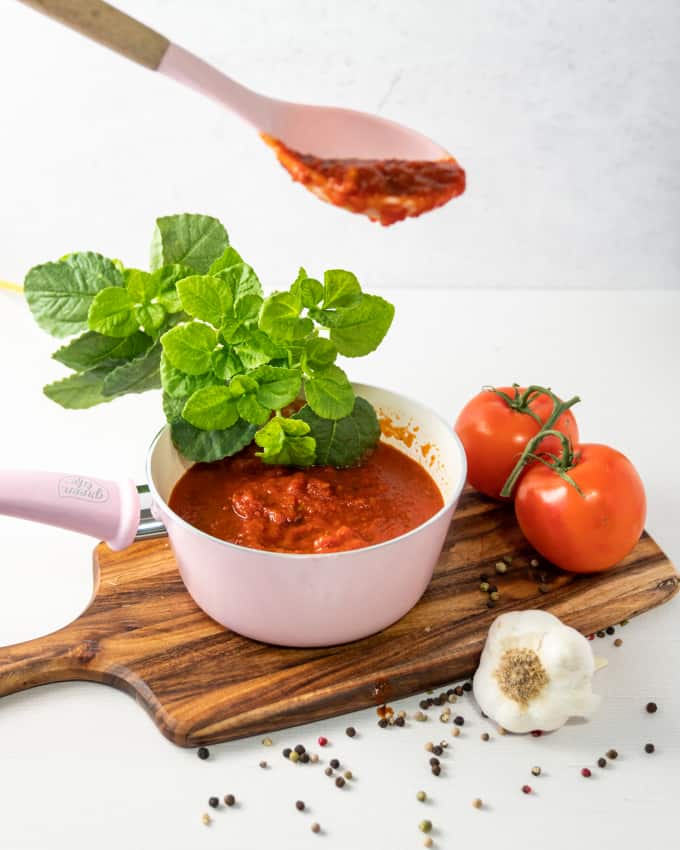
This Five Cheese Marinara is very simple to make, yet hearty and satisfying.
Serve it over your favorite pasta!

2. Amatriciana
Originating from the town of Amatrice in Lazio, Italy; this tomato-based sauce is called salsa all’amatriciana or sugo all’amatriciana, and may very well be a derivative of pasta alla gricia that’s popular in Rome.
Amatriciana is very popular in Roman cuisine, the sauce is made of tomatoes, onions, Amatrician pecorino cheese, and guanciale which is a cured pork cheek. Some recipes replace the guanciale with pancetta which is a cured pork belly.
This Classic Pasta Amatriciana is a quick and easy Italian pasta recipe for the perfect dinner.
It goes perfectly with a sautéed pancetta.

3. Alla Norma
A Sicilian pasta that originated in the Catania region of Italy, the pasta alla norma is made with macaroni, fried eggplant, basil, ricotta cheese, and marinara sauce.
How did it get the name Norma?
According to local legends, the Italian writer Nino Martoglio tried this version of the pasta in the early 20th century. After tasting the pasta he said, “This is a real Norma!” in comparing it to the magnificent Vincenzo Bellini opera called Norma that premiered at La Scala in 1831, Nino forever changed the history of the dish, making it truly as beautiful and heavenly as the opera!
This Pasta Alla Norma recipe is a quick and easy eggplant and tomato based sauce.
In my opinion it goes best with bigoli pasta, but if you can’t find any I recommend tagliatelle.
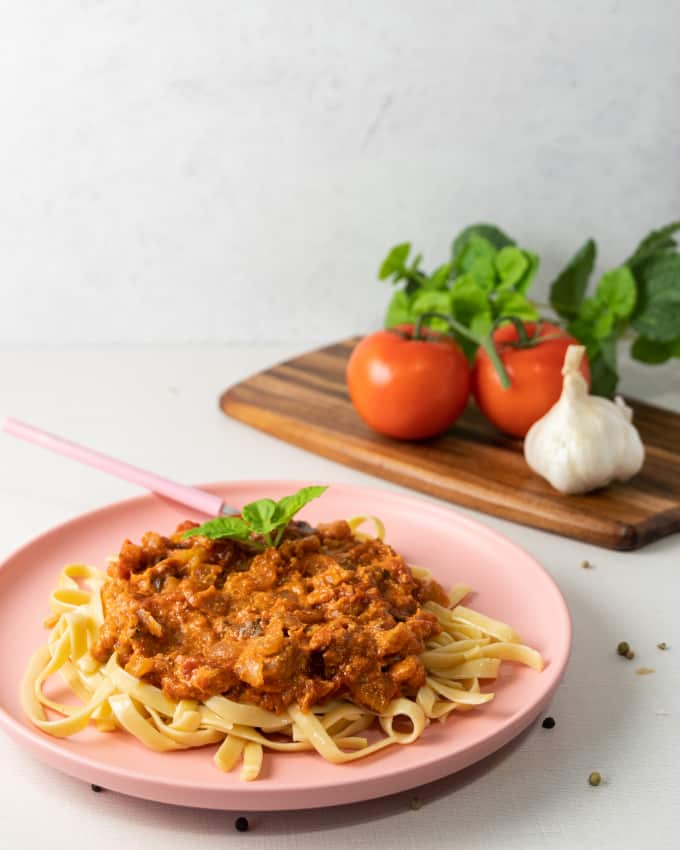
4. Ragu vs Bolognese
Have you heard of the Bolognese sauce? The one used in Spaghetti alla Bolognese with minced meat, that’s popular all over the world? Almost every Italian restaurant in the US has it on the menu. But travel to Italy and you’ll find it doesn’t really exist! Well, at least not as a Bolognese sauce, but as a ragu.
The Bolognese sauce that we love eating with most meat dishes or with minced meat and spaghetti is actually a variety of the Italian ragu sauce or meat sauce. And because this version originated in Bologna, it’s called ragu alla Bolognese.
The main ingredients of a ragu alla Bolognese are celery, onions, and carrot, not forgetting the minced pancetta, or beef mince, or bacon. Sometimes white wine, minced tomato, heavy cream, or milk are also added to thicken the sauce.
Anyways, if you don’t find Bolognese on the menu, just look for its parent sauce ragu, and you’ll find exactly what you need.
This is another must-try classic Italian Bolognese sauce with vegan ingredients!
Grated carrots, mushrooms, ground walnuts, and onions come together with a rich and savory sauce for the perfect vegan sauce!

5. Carbonara
Arriving on the world scene in the middle half of the 20th century, the spaghetti alla carbonara may have originated in Lazio like the Amatricana did. A smooth, creamy, and indulgent dish, the carbonara is made with Parmesan cheese, olive oil, pepper, eggs, and pancetta or guanciale.
The eggs used in the carbonara sauce are not cooked on their own, but stirred into the hot pasta after taking it off the flame. This results in a sauce with a silky finish.
One of the creamiest Italian dishes, the creamy Classic Carbonara is made without cream.
Using, pancetta, eggs, pasta, and cheese, dinner will be ready in under 30 minutes.
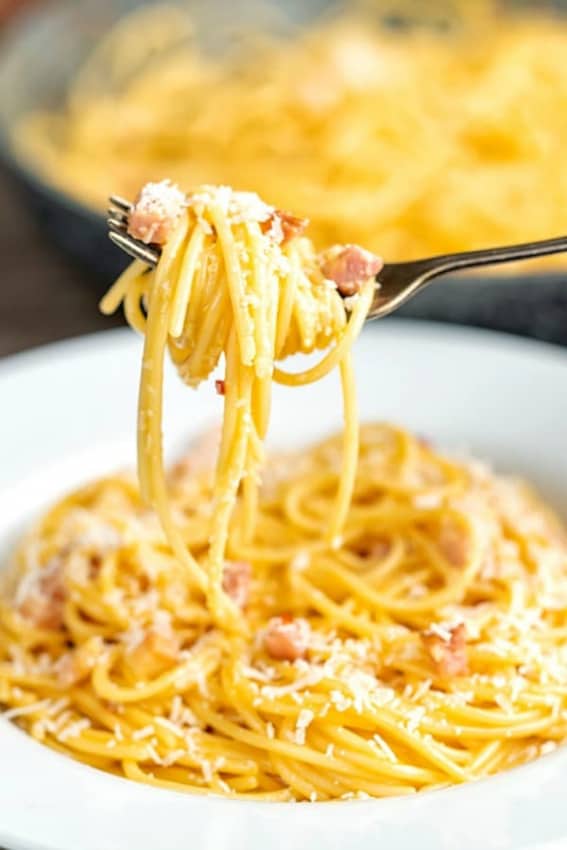
If you love Italian food but are looking for something that’s truly out of this world, try this mushroom carbonara and udon noodles recipe!
A fusion of the Japanese and Italian cultures, the creamy carbonara sauce with udon noodles is a filling dinner!
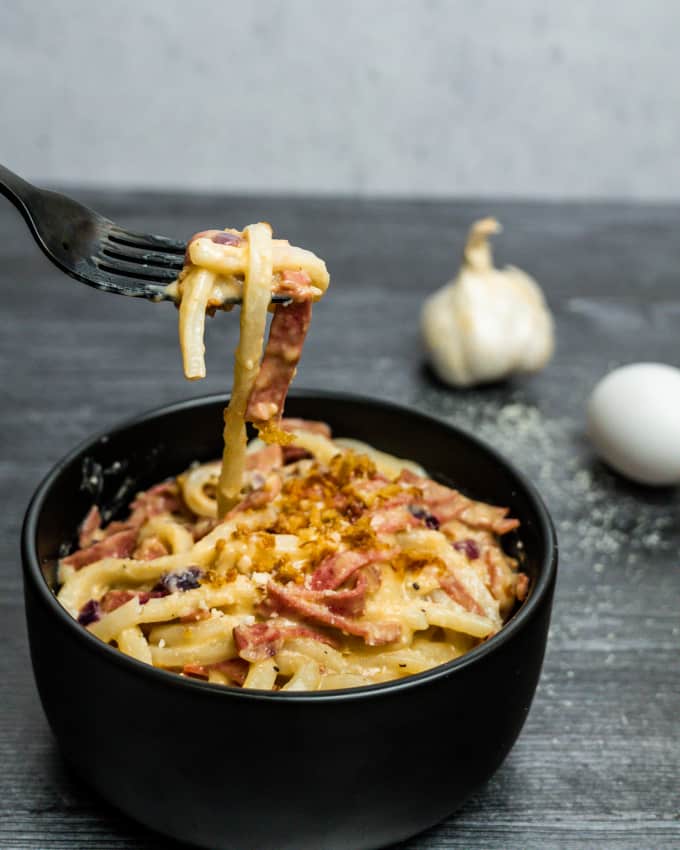
6. Boscaiola
The Bosciaola sauce is quite similar to the carbonara in taste but uses porcini mushrooms instead of meat or chicken. The sauce is made by slicing the porcini mushrooms and simmering them with white wine, garlic, onions, black pepper, and bacon.
The word ‘bosco’ means wood and ‘boscaiola’ means ‘the woodcutter’s wife’. The earthiness and smokiness of the dish reminds you of the woods in autumn.
This Boscaiola pasta recipe is also known in the US as Mushroom Strogonoff.
I highly recommend using wild mushrooms in addition to standard mushrooms – it will change the flavor.
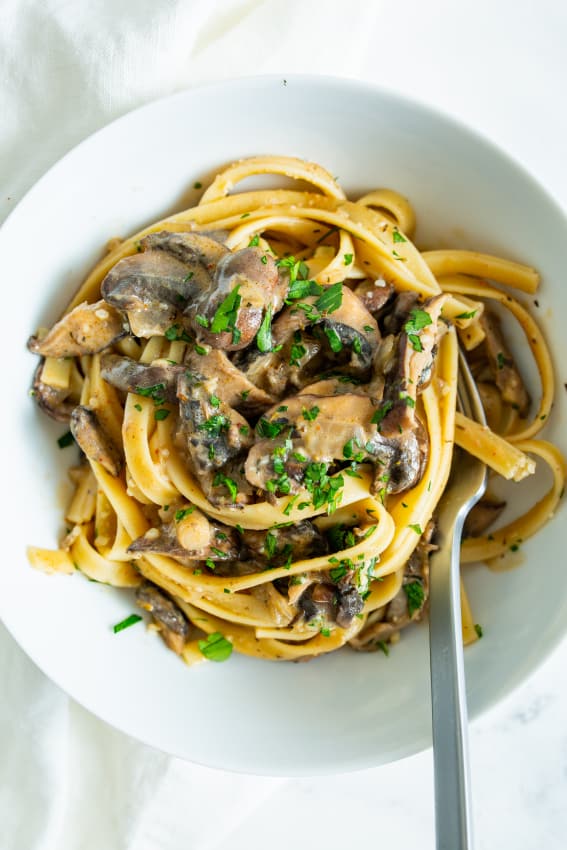
7. Cacio e Pepe
Literally translating to “cheese and pepper”, cacio e pepe is the Roman version of a “mac an cheese”. Only, it’s made with tonnarelli or spaghetti pasta. Using simple ingredients, but requiring an technique to get just right, one might think that the cacio e pepe is easy to make. The truth is different.
Pasta has to be cooked to the right amount, cheese added at the right temperature, and excess cooking water used to bind the cheese and pepper to the pasta. No wonder this trendy dish has many varying opinions on how to make it!
Stimulating pepper and creamy pecorino cheese come together to turn into the perfect Cacio e Pepe recipe.

8. Pesto
Pesto alla Genovese, usually referred to just as Pesto, is a sauce from the Northern Italian city of Genoa in Liguria. Pesto sauce was derived from two possible sources.
One, the Roman moretum, a sauce made by crushing garlic, cheese, and herbs, with salt, vinegar,and olive oil. The other source was the Genoan agliata, a paste of walnuts and garlic that was popular in the Middle Ages.
The modern-day pesto sauce is a mix of pine nuts, crushed garlic, dried basil leaves, salt, olive oil, and a hard cheese such as the Parmesan (Parmigiano-Reggiano) or the sheep’s milk cheese Pecorino Sardo, that are all pounded together using a mortar and pestle.
The name Pesto is truly apt since the word is derived from the Genoese word pestâ which means to pound or to crush, just like the ingredients of the Pesto sauce have been.
This Pesto alla Genovese is the perfect combination of pine nuts and basil to add to your pasta or use as a spread.
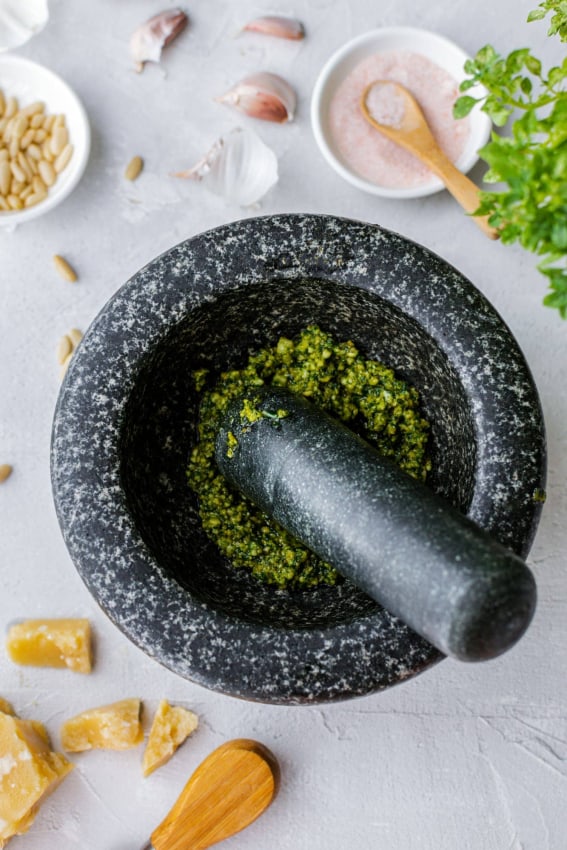
If you or your loved ones are allergic to nuts, it doesn’t mean you have to skip eating pesto sauce.
This gratifying pesto sauce replaces the creaminess of pine nuts with bananas, and makes it quite impressive!

9. Puttanesca
The Puttanseca sauce is associated with the word “puttana” or “prostitute” in Italian. It’s popularly believed that originated in brothels to lure customers in with its aromas.
But the truth is quite different.
In the 1950s, one of the co-owners of Rancio Fellone, Sandro Petti was closing down for the night. But a group of people had just arrived and wanted food.
He told them that he didn’t have many ingredients left, but they told him “Facci una puttanata qualsiasi” which means just throw anything together. And he did just that!
The sugo alla puttanesca was made with olives, capers, and tomatoes. After that, Petti added the spaghetti alla puttanesca as a regular feature on his menu. The current-day version of the sauce may also include garlic, tuna, and anchovies.
Made with a roasted tomato sauce, this Spaghetti Puttanesca with anchovies is a great year-round dish.
And it can be made with fresh or homemade tomatoes. Try this aromatic puttanesca yourself!
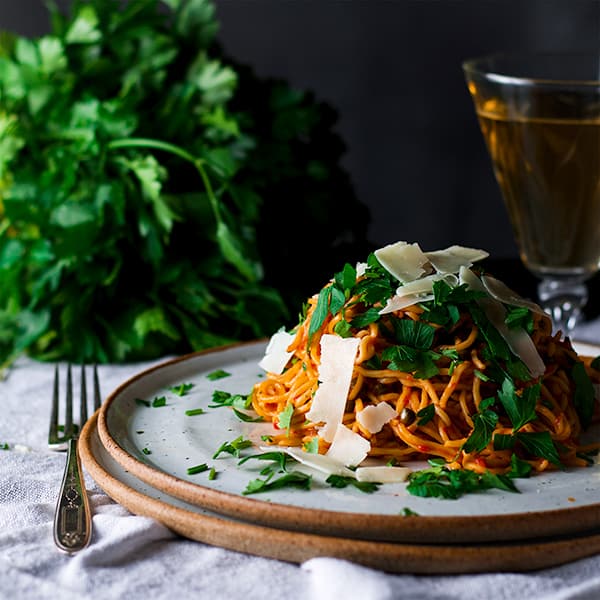
10. Al Tartufo
One of nature’s delights, truffles have been used in cooking in the Italian region of Umbria for many years, especially in the Piedmont area.
The softer and rarer white truffles cost anywhere from 2000 to 6000 Euros a kg, while the more affordable black truffles cost around 200 to 600 Euros a kg. Both the white and black variety of truffles find their way into pasta dishes.
Nowadays, truffle hunters train dogs to search for truffles, but did you know that in the olden days they used female pigs to look for truffles? Why? Because truffles contain the molecule androstenone that makes them smell similar to male pigs.
A salsa di tartufo is made using wild porcini mushrooms, black summer truffles and black olives, while a pasta al tartufo is a dish of pasta and white or black truffles, served with butter. Some Italians also add parmesan cheese, but others consider it a sin. The most popular version of the pasta al tartufo is the tagliolini al tartufo.
Why tagliolini? Because the egg-rich strands of the tagliolini or tajarin pasta complement for the white truffles.
A simple traditional recipe for tagliolini with white truffles, this Parmesan flavored tagliolini pasta is creamy and delicious!

11. Alla Vodka
Pasta alla vodka or penne alla vodka appeared on the food scene in the 1980s. Although its origins are unclear, using vodka in pasta was first mentioned in 1974 by the Italian actor Ugo Tognazzi in his cookbook L’Abbuffone.
Some say the pasta was invented by a Roman chef for a vodka company, some say it was invented by the restaurant Dante in Bologna, Italy, and others say it was invented by a James Doty who graduated from Columbia University.
The penne alla vodka is a mix of creamy sauce and marinara sauce with vodka.
And whoever invented the alla vodka, it is now quite a popular dish in Italian-American cuisine.

12. Bechamel or Besciamella
One of the main foundation sauces, the béchamel sauce is roux-based sauce made with flour, butter, and milk, and often includes nutmeg and salt as a flavoring. Béchamel sauce is also called besciamella in Italy.
The origin of the sauce has been debated for centuries. The Italians say they have been cooking it for centuries as besciamella, or balsamella, or bechimella.
The Italians say the sauce was created after 1533 by the Italian chefs of Catherine de Medici, the Italian-born Queen of France. Queen Catherine’s Italian cooks introduced Italian cooking to France, and the besciamella was a big part of it.
Of course, the French claim that béchamel originated in the reign of Louis the XIV in France.
And the Italians have 3 more theories for the origin of the béchamel sauce. But no matter which country created it, this Italian Renaissance recipe is a must add to your cooking repertoire.
This authentic Italian bechamel recipe is quick and easy and goes well with lasagne, vegetables, or any sort of pies – especially fish.




